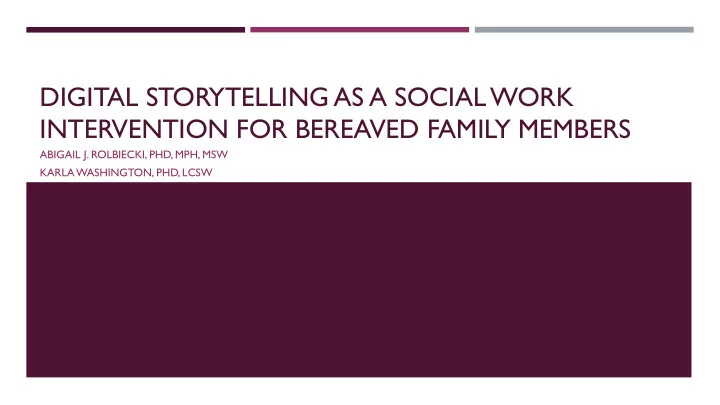

DIGITAL STORYTELLING AS A SOCIAL WORK INTERVENTION FOR BEREAVED FAMILY MEMBERS ABIGAIL J. ROLBIECKI, PHD, MPH, MSW KARLA WASHINGTON, PHD, LCSW
INTRODUCTION Abigail J. Rolbiecki Social worker & scholar Narrative interventionist – Photo elicitation methods and Digital Storytelling Background in trauma & adverse life experiences Bereaved sibling Constructivist & Storyteller Karla Washington
“In some ways suffering ceases to be suffering at the moment it finds a meaning…” – Viktor Frankl
STORYTELLING AND THE SEARCH FOR MEANING Organization of memory in a chronological timeline. Developing and verbalizing the story promotes meaning-making and healing. Storytelling has been shown to reduce: Depression Anxiety Storytelling has been shown to improve: Self-efficacy Communication skills Social support Quality of life
DIGITAL STORYTELLING AS A SW BEREAVEMENT INTERVENTION University of Missouri, Center for Patient-Centered Outcomes Research Awarded 20k internal funds Primary Aim: Feasibility of Digital Storytelling as a Bereavement Intervention Criteria for participation: Bereaved family member Bereaved up to 2.5 years Willing to participate in the intervention and share story N = 14 n = 6 Cancer Death n = 3 Dementia Death n = 3 Non-illness related death (e.g., accident) n = 2 “Other” illness related death (e.g., heart disease/death)
WHAT IS DIGITAL STORYTELLING? Multi-media, narrative intervention combining photography, music, and spoken word. Commonly used in community health intervention, education, and journalism. Palliative care and health storytelling research: Figure 1. Adapted Constructivist Meaning-Making Model Decreased PTSD Pre-loss meaning Structures: -Daily activities Digital Storytelling Process: Emotional Decreased depression and anxiety -Self-perceptions Loss of -Sense making Distress -Interpersonal family -Benefit Finding (depression relationships patient -Identity Change /anxiety) -Views of future and Improved ability to make meaning world -Spirituality Pediatric palliative care – legacy making. Post-loss meaning Structures: -New activities/re- Reduced risk examined priorities Adapted Gillies and Neimeyer model. Decreased of Complicated -New self/personal growth Distress Grief -New relationships with living & continuing bonds with dead -New views of world and future -New faith Source: Gillies, J. & Neimeyer, R.A. (2006) Loss, grief, and the search for significance: Toward a model of meaning reconstruction in bereavement. Journal of Constructivist Psychology, 19, 31-65.
RECRUITMENT STRATEGY Convenient recruitment strategy MU Info Most successful o Flyering Snowball (word of mouth)
ACTIVITIES AFTER CONSENT In person meeting 5-day workshops (two full days; two optional ½ days; 1 final ½ day for group share) Group story circles script development/sharing. Story Circle 1: Identifying the story; timeline Story Circle 2: Sharing the narrative with the group Story Circle 3: Sharing the actual digital story Individual journaling supported script development. Think visually What photos or other artifacts can bring life to the parts of your narrative
VISUALIZING THE SCRIPT: THE STORYBOARD/TIMELINE
CREATING THE DIGITAL STORY Recorded narratives (via iPad) iMovie (readily available software on ALL newer apple products) Free o PC equivalent – Windows moviemaker o Demo the digital story Finalize and upload to sharable file
SHARING THE DIGITAL STORY Story Circle 3 (or final story circle) Most powerful piece to Digital Storytelling Symbolic of a person re-entering their world with a narrative solely authored by themselves. Reclaimed control over their story, and their healing.
EXAMPLE DIGITAL STORY
PRELIMINARY FINDINGS Main finding/goal: This is a FEASIBLE intervention approach for this study population. DS can be feasibly implemented in smart technology (i.e., an Apple IPad Air 2). Participants found the intervention helpful/meaningful “Digital Storytelling really helped me focus on what I think the purpose of my family going through this was. I can take what we’ve gone through and find meaning and purpose in the [experience].” Participants primarily valued having devoted time and space to craft their stories (with support) and share them with others who had experienced similar loss.
QUALITATIVE DATA Participants felt this approach supports open communication about feelings of grief and loss. Participants felt this approach supported the meaning-making process, particularly in terms of them making sense of their loss experience (i.e., understanding it’s purpose in their life). Participants felt this would be an important intervention approach for individuals who are preparing for the loss of their loved one: “there are these long period where caregivers are waiting for their loved ones to die…having something like storytelling as a [tool] for processing grief would [be] extremely helpful .” Participants ended feeling proud of their product, as well as more self-confident in their ability to use technology (a finding we were not necessarily anticipating).
IMPACT ON DEPRESSION AND ANXIETY Figure 1. Distribution of Depression
CONCLUSIONS Digital Storytelling is a highly feasible psychosocial intervention that holds great promise as a tool to support healing among individuals bereaved by chronic illness. The workshop format provided ample support for participants to learn to use Digital Storytelling technologies; including participants with varying levels of experience with such technologies. Participants cited the physical space, dedicated time, emotional support, and technological support as elements of the Digital Storytelling Experience that contributed to its benefit.
THANK-YOU! Abigail J. Rolbiecki, PhD, MPH, MSW Rolbieckia@health.missouri.edu
Recommend
More recommend